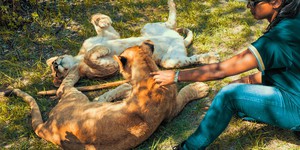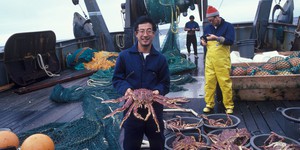Abstract
Baby Beluga may swim in the deep blue sea, but the song does not mention how cold it is out there! Find out in this science project how a bit of blubber can be a useful adaptation when the water is ice cold. Brrrr!Summary
Sara Agee, PhD, Science Buddies
- Crisco® is a registered trademark of The J. M. Smucker Company.
Objective
Test whether or not a layer of blubber is a helpful adaptation for cold-water environments.
Introduction
Do you ever wonder what makes each species of animal unique? Where does all of the diversity of life on this planet come from? The key to this puzzle is called evolution, which is the process by which groups of organisms change over time, from generation to generation, leading to the development of new species. The key to evolution is a process called natural selection, sometimes referred to as "survival of the fittest." Natural selection presents a challenge to all the different types in a population, allowing those who overcome the challenge and reproduce, to pass on useful traits to their descendants, which increases that population's fitness and survival.
Evolution and natural selection were first proposed by Charles Darwin. While on a long voyage on a ship named the HMS Beagle, he was able to observe and document many useful traits, called adaptations, of animals he saw. An adaptation is a trait that comes in handy when an organism has to deal with a challenge. Adaptations take many generations to appear in a population, but the results are worth it. Many of the changes that lead to an adaptation are random, but natural selection picks through and determines which adaptations will continue from generation to generation.
To experience some adaptations that have increased the fitness of an organism, act out the three behaviors below:
- Flap your arms like wings - The wings of birds are an adaptation for flight. When the bones of the wing are spread out, they create a skeleton with a large surface area for an aerodynamically shaped wing, which means it is shaped for flight. When covered with feathers, the wing produces lift and can also be used to glide. Birds also have hollow bones that keep their body weight low, large chest muscles for flapping, and a large breast plate where the chest muscles attach. As you flap your arms, you may notice that your chest muscles begin to feel tired. Umm, you can stop now...don't overdo it!
- Walk straight and tall - Walking upright, or being bipedal, is a special adaptation of hominids, a special group of primates that includes humans (Homo sapiens) and their close relatives (like Neanderthals or Australopithecus). Other primates, like chimpanzees and gorillas, must use their forearms when walking, and do not walk upright. This adaptation gave hominids an advantage in interacting with the environment, and might have led to the development of larger brain sizes in our hominid ancestors. Scientists believe that walking upright was an adaptive trait that allowed hominids eventually to become better hunters and gatherers, and to develop tools to use for these activities. As you walk around, notice that your arms are free to move, how quickly you can observe your environment, and how quickly and easily you can move and change direction.
- Fold your arms and shiver - Shivering is an adaptation shared by other mammals to stay warm when temperatures become cooler. Mammals are warm-blooded, meaning our metabolism makes up a lot of our body heat, and we do not get most of our warmth from the environment. However, the environment can still affect us. Sometimes we get chilly, so shivering produces body movements, which briefly speeds up our metabolism, warming us up. It is also a good signal to the brain to find a warmer place to go! Now go grab a blanket, silly!
Terms and Concepts
- Diversity
- Evolution
- Generation
- Natural selection
- Descendant
- Adaptation
- Metabolism
- Blubber
- Adipose tissue
- Heat transfer
Questions
- What is an adaptation?
- How does blubber keep polar bears warm?
- What other marine animals use blubber as an adaptation?
Bibliography
The original source of this project is the San Diego Zoo:- San Diego Zoo. (2007). San Diego Zoo's Science Project: How Do Polar Bbbears Stay Wwwarm? Zoological Society of San Diego, CA. Retrieved December 6, 2007.
- Kimball, J. (2007). Evolution and Adaptation. Andover, MA: Kimball's Biology Pages. Retrieved December 6, 2007.
- UCMP. (2006). Evolution 101: Adaptation. University of California Museum of Paleontology (UCMP), University of California, Berkeley; and the National Center for Science Education (NCSE). Retrieved December 6, 2007.
This website offers help with creating graphs:
- National Center for Education Statistics. (n.d.). Create a Graph. Retrieved August 27, 2008.
Materials and Equipment
- Empty bowls (2)
- Cold water
- Warm water
- Ice cubes
- Shortening (like Crisco®)
- Paper towels
- Stopwatch
- Celsius thermometer, available from Carolina Biological, item #: 745390
- A partner
Disclaimer: Science Buddies participates in affiliate programs with Home Science Tools, Amazon.com, Carolina Biological, and Jameco Electronics. Proceeds from the affiliate programs help support Science Buddies, a 501(c)(3) public charity, and keep our resources free for everyone. Our top priority is student learning. If you have any comments (positive or negative) related to purchases you've made for science projects from recommendations on our site, please let us know. Write to us at scibuddy@sciencebuddies.org.
Experimental Procedure
- Fill two bowls with cold water and ice cubes.
- Measure the temperature of the water with a thermometer. When the temperature levels off, the bowls are ready. Write down the temperature of the water in your lab notebook in a data table like Table 1 below.
| Water Bowl | Water Temperature (°Celsius) | Covered Finger Time (sec) | Uncovered Finger Time (sec) |
|---|---|---|---|
| Ice-Cold | |||
| Ice-Cold | |||
| Ice-Cold | |||
| AVERAGE | |||
| Warm | |||
| Warm | |||
| Warm | |||
| AVERAGE |
- Cover the pointer finger on one hand with a thick layer of shortening.
- Have your partner prepare the stopwatch, and when he or she says go, put the pointer finger of each hand into one of the bowls of ice water.
- Have your partner time how long you can leave each finger in the bowl, and write the results in a data table.
- Wait until your fingers return to their normal color, then repeat steps 3–5 two times and average your results.
- Switch partners and repeat steps 2–6.
- Repeat the entire experiment with warm water. Predict whether you think you will see the same result.
- Calculate your result averages and make a bar graph of your average results.
- On the vertical axis (the y-axis), put the time (in seconds), and on the horizontal axis (the x-axis) make four bars, one for each of the following results: Average time in the ice-cold water with a covered finger; Average time in the ice-cold water with an uncovered finger; Average time in the warm water with a covered finder; Average time in the warm water with an uncovered finger.
- You can make the bar graph by hand or use a website like Create a Graph to make the graph on the computer and print it.
- Analyze your results and try to draw some conclusions. In which environment did the adaptation give a significant advantage?
Ask an Expert
Global Connections
The United Nations Sustainable Development Goals (UNSDGs) are a blueprint to achieve a better and more sustainable future for all.
Variations
Can you model other types of adaptations to show how they increase fitness? Here are some ideas:
- Plants - Some plants have waxy leaves, and some have regular leaves. Waxy leaves are common in plants that live in dry environments, and keep the plant from losing water. You can model the waxy coating of a leaf by covering a moist sponge with a layer of shortening. Will an uncovered sponge dry out before a covered sponge? Do waxy leaves resist drying out better than regular leaves?
- Long tails - animals with long tails often use them for balance. Make a model of a rat, monkey or other animal with a long tail. Can you use a balance test on your model to find out if the tail adds stability?
- Big ears - Animals that are nocturnal, or spend most of their wake hours at night, often have big ears. Can you do an experiment with ear cones to show how this adaptation can increase hearing ability? Why would this be useful for an animal that hunts at night?
- Webbed feet - Try the Science Buddies Experiment The Swimming Secrets of Duck Feet to see if duck feet can help you swim faster.
Careers
If you like this project, you might enjoy exploring these related careers:










